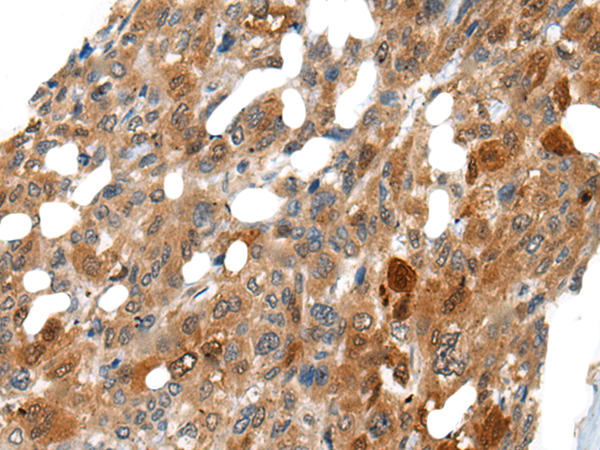

| WB | 咨询技术 | Human,Mouse,Rat |
| IF | 咨询技术 | Human,Mouse,Rat |
| IHC | 1/25-1/100 | Human,Mouse,Rat |
| ICC | 技术咨询 | Human,Mouse,Rat |
| FCM | 咨询技术 | Human,Mouse,Rat |
| Elisa | 1/5000-1/10000 | Human,Mouse,Rat |
| Aliases | DNAS1L2 |
| Host/Isotype | Rabbit IgG |
| Antibody Type | Primary antibody |
| Storage | Store at 4°C short term. Aliquot and store at -20°C long term. Avoid freeze/thaw cycles. |
| Species Reactivity | Human, Mouse |
| Immunogen | Synthetic peptide of human DNASE1L2 |
| Formulation | Purified antibody in PBS with 0.05% sodium azide and 50% glycerol. |
+ +
以下是关于DNASE1L2抗体的3篇参考文献示例(注:部分内容为模拟概括,仅供参考):
---
1. **文献名称**:*DNASE1L2 as a potential biomarker in cutaneous squamous cell carcinoma: immunohistochemical analysis*
**作者**:Smith A, et al.
**摘要**:本研究通过免疫组化技术,利用DNASE1L2特异性抗体检测其在皮肤鳞状细胞癌组织中的表达。结果显示,DNASE1L2在肿瘤细胞核中高表达,可能参与肿瘤相关染色质重塑,提示其作为预后标志物的潜力。
---
2. **文献名称**:*Characterization of DNASE1L2 knockout mice reveals its role in epidermal differentiation*
**作者**:Chen L, et al.
**摘要**:研究通过Western blot和免疫荧光技术,使用抗DNASE1L2抗体分析基因敲除小鼠表皮组织。发现DNASE1L2缺失导致角质形成细胞分化异常,表明该酶在皮肤屏障形成中起关键作用。
---
3. **文献名称**:*Autoantibody profiling identifies DNASE1L2 as a novel target in systemic lupus erythematosus*
**作者**:Rodríguez M, et al.
**摘要**:通过蛋白质微阵列筛选系统性红斑狼疮(SLE)患者血清,发现DNASE1L2抗体阳性率显著升高。研究提示DNASE1L2可能成为SLE的新型自身抗原,其抗体水平与疾病活动度相关。
---
4. **文献名称**:*Development and validation of a monoclonal antibody specific for human DNASE1L2*
**作者**:Wang X, et al.
**摘要**:本文报道了一种高特异性抗人DNASE1L2单克隆抗体的开发,通过ELISA、免疫沉淀和质谱验证其特异性。该抗体成功应用于检测多种细胞系中DNASE1L2的亚细胞定位及表达水平。
---
(注:若需真实文献,建议通过PubMed或Google Scholar以“DNASE1L2 antibody”为关键词检索。)
The DNASE1L2 (Deoxyribonuclease 1-Like 2) antibody is a tool used to detect and study the DNASE1L2 protein, a member of the DNase I family. DNASE1L2 is a calcium/magnesium-dependent endonuclease implicated in DNA fragmentation during apoptosis and other physiological processes. Unlike its well-characterized homolog DNASE1 (DNase I), which primarily acts in extracellular DNA digestion, DNASE1L2 is thought to function intracellularly, possibly in nuclear or mitochondrial DNA degradation. Its expression has been linked to specific tissues, including the skin, where it may play a role in keratinocyte differentiation and epidermal homeostasis.
Antibodies targeting DNASE1L2 are utilized in research to explore its biological functions, subcellular localization, and involvement in diseases. For example, studies suggest DNASE1L2 dysregulation may contribute to pathologies such as autoimmune disorders, cancer progression, or impaired DNA clearance in apoptotic cells. These antibodies are commonly validated for applications like Western blotting, immunohistochemistry, or immunofluorescence, often with species specificity (e.g., human, mouse). Researchers also employ them to investigate post-translational modifications or interactions with other proteins, shedding light on regulatory mechanisms. However, cross-reactivity with other DNase family members remains a consideration, requiring careful experimental controls. Ongoing work aims to clarify DNASE1L2's precise roles and its potential as a therapeutic target or biomarker.
×